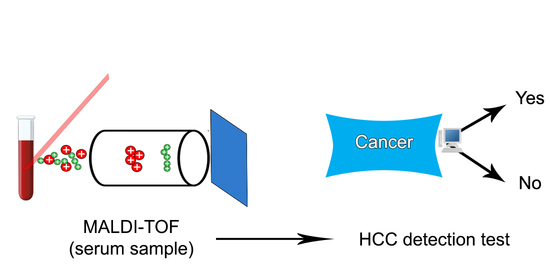Detection of Hepatocellular Carcinoma in a High-Risk Population by a Mass Spectrometry-Based Test
Abstract
:Simple Summary
Abstract
1. Introduction
2. Materials and Methods
2.1. Patient Cohorts
2.2. Methods
2.2.1. Sample Collection and Storage
2.2.2. Mass Spectral Acquisition
2.2.3. Mass Spectral Processing
2.2.4. AFP Measurement
2.2.5. Application of an Existing MS-Based Serum Proteomic Test
2.2.6. Development of the HCC Detection Test
- 1.
- Machine Learning Approach
- 2.
- Test Development
2.2.7. Application of the HCC Detection Test to Validation Samples
2.2.8. Independent Validation
2.2.9. Statistical Methods
3. Results
4. Discussion
5. Conclusions
Supplementary Materials
Author Contributions
Funding
Institutional Review Board Statement
Informed Consent Statement
Data Availability Statement
Acknowledgments
Conflicts of Interest
References
- Bray, F.; Ferlay, J.; Soerjomataram, I.; Siegel, R.L.; Torre, L.A.; Jemal, A. Global cancer statistics 2018: GLOBOCAN estimates of incidence and mortality worldwide for 36 cancers in 185 countries. CA Cancer J. Clin. 2018, 68, 394–424. [Google Scholar] [CrossRef] [Green Version]
- El-Serag, H.B. Epidemiology of viral hepatitis and hepatocellular carcinoma. Gastroenterology 2012, 142, 1264–1273.e1261. [Google Scholar] [CrossRef] [Green Version]
- Fattovich, G.; Stroffolini, T.; Zagni, I.; Donato, F. Hepatocellular carcinoma in cirrhosis: Incidence and risk factors. Gastroenterology 2004, 127, S35–S50. [Google Scholar] [CrossRef]
- Marrero, J.A.; Kulik, L.M.; Sirlin, C.B.; Zhu, A.X.; Finn, R.S.; Abecassis, M.M.; Roberts, L.R.; Heimbach, J.K. Diagnosis, Staging, and Management of Hepatocellular Carcinoma: 2018 Practice Guidance by the American Association for the Study of Liver Diseases. Hepatology 2018, 68, 723–750. [Google Scholar] [CrossRef] [Green Version]
- Singal, A.G.; Pillai, A.; Tiro, J. Early detection, curative treatment, and survival rates for hepatocellular carcinoma surveillance in patients with cirrhosis: A meta-analysis. PLoS Med. 2014, 11, e1001624. [Google Scholar] [CrossRef]
- Tateishi, R.; Yoshida, H.; Matsuyama, Y.; Mine, N.; Kondo, Y.; Omata, M. Diagnostic accuracy of tumor markers for hepatocellular carcinoma: A systematic review. Hepatol. Int. 2008, 2, 17–30. [Google Scholar] [CrossRef] [Green Version]
- European Association for the Study of the Liver. Electronic address, e.e.e.; European Association for the Study of the, L. EASL Clinical Practice Guidelines: Management of hepatocellular carcinoma. J. Hepatol. 2018, 69, 182–236. [Google Scholar] [CrossRef] [Green Version]
- Sengupta, S.; Parikh, N.D. Biomarker development for hepatocellular carcinoma early detection: Current and future perspectives. Hepatic Oncol. 2017, 4, 111–122. [Google Scholar] [CrossRef]
- De Stefano, F.; Chacon, E.; Turcios, L.; Marti, F.; Gedaly, R. Novel biomarkers in hepatocellular carcinoma. Dig. Liver Dis. 2018, 50, 1115–1123. [Google Scholar] [CrossRef]
- Koike, Y.; Shiratori, Y.; Sato, S.; Obi, S.; Teratani, T.; Imamura, M.; Yoshida, H.; Shiina, S.; Omata, M. Des-gamma-carboxy prothrombin as a useful predisposing factor for the development of portal venous invasion in patients with hepatocellular carcinoma: A prospective analysis of 227 patients. Cancer 2001, 91, 561–569. [Google Scholar] [CrossRef]
- Sterling, R.K.; Jeffers, L.; Gordon, F.; Sherman, M.; Venook, A.P.; Reddy, K.R.; Satomura, S.; Schwartz, M.E. Clinical utility of AFP-L3% measurement in North American patients with HCV-related cirrhosis. Am. J. Gastroenterol. 2007, 102, 2196–2205. [Google Scholar] [CrossRef]
- Johnson, P.J.; Pirrie, S.J.; Cox, T.F.; Berhane, S.; Teng, M.; Palmer, D.; Morse, J.; Hull, D.; Patman, G.; Kagebayashi, C.; et al. The detection of hepatocellular carcinoma using a prospectively developed and validated model based on serological biomarkers. Cancer Epidemiol. Biomark. Prev. 2014, 23, 144–153. [Google Scholar] [CrossRef] [Green Version]
- Berhane, S.; Toyoda, H.; Tada, T.; Kumada, T.; Kagebayashi, C.; Satomura, S.; Schweitzer, N.; Vogel, A.; Manns, M.P.; Benckert, J.; et al. Role of the GALAD and BALAD-2 Serologic Models in Diagnosis of Hepatocellular Carcinoma and Prediction of Survival in Patients. Clin. Gastroenterol. Hepatol. 2016, 14, 875–886.e6. [Google Scholar] [CrossRef] [PubMed] [Green Version]
- Yang, J.D.; Addissie, B.D.; Mara, K.C.; Harmsen, W.S.; Dai, J.; Zhang, N.; Wongjarupong, N.; Ali, H.M.; Ali, H.A.; Hassan, F.A.; et al. GALAD Score for Hepatocellular Carcinoma Detection in Comparison with Liver Ultrasound and Proposal of GALADUS Score. Cancer Epidemiol. Biomark. Prev. 2019, 28, 531–538. [Google Scholar] [CrossRef] [Green Version]
- Aebersold, R.; Mann, M. Mass spectrometry-based proteomics. Nature 2003, 422, 198–207. [Google Scholar] [CrossRef]
- Taguchi, F.; Solomon, B.; Gregorc, V.; Roder, H.; Gray, R.; Kasahara, K.; Nishio, M.; Brahmer, J.; Spreafico, A.; Ludovini, V.; et al. Mass spectrometry to classify non-small-cell lung cancer patients for clinical outcome after treatment with epidermal growth factor receptor tyrosine kinase inhibitors: A multicohort cross-institutional study. J. Natl. Cancer Inst. 2007, 99, 838–846. [Google Scholar] [CrossRef] [Green Version]
- van Adrichem, J.H.; Bornsen, K.O.; Conzelmann, H.; Gass, M.A.; Eppenberger, H.; Kresbach, G.M.; Ehrat, M.; Leist, C.H. Investigation of protein patterns in mammalian cells and culture supernatants by matrix-assisted laser desorption/ionization mass spectrometry. Anal. Chem. 1998, 70, 923–930. [Google Scholar] [CrossRef]
- Zinkin, N.T.; Grall, F.; Bhaskar, K.; Otu, H.H.; Spentzos, D.; Kalmowitz, B.; Wells, M.; Guerrero, M.; Asara, J.M.; Libermann, T.A.; et al. Serum proteomics and biomarkers in hepatocellular carcinoma and chronic liver disease. Clin. Cancer Res. 2008, 14, 470–477. [Google Scholar] [CrossRef] [Green Version]
- Tsypin, M.; Asmellash, S.; Meyer, K.; Touchet, B.; Roder, H. Extending the information content of the MALDI analysis of biological fluids via multi-million shot analysis. PLoS ONE 2019, 14, e0226012. [Google Scholar] [CrossRef] [Green Version]
- Muller, M.; Hummelink, K.; Hurkmans, D.P.; Niemeijer, A.-L.N.; Monkhorst, K.; Roder, J.; Oliveira, C.; Roder, H.; Aerts, J.G.; Smit, E.F. A Serum Protein Classifier Identifying Patients with Advanced Non–Small Cell Lung Cancer Who Derive Clinical Benefit from Treatment with Immune Checkpoint Inhibitors. Clin. Cancer Res. 2020, 26, 5188. [Google Scholar] [CrossRef]
- Weber, J.S.; Sznol, M.; Sullivan, R.J.; Blackmon, S.; Boland, G.; Kluger, H.M.; Halaban, R.; Bacchiocchi, A.; Ascierto, P.A.; Capone, M.; et al. A Serum Protein Signature Associated with Outcome after Anti-PD-1 Therapy in Metastatic Melanoma. Cancer Immunol. Res. 2018, 6, 79–86. [Google Scholar] [CrossRef] [Green Version]
- Fidler, M.J.; Fhied, C.L.; Roder, J.; Basu, S.; Sayidine, S.; Fughhi, I.; Pool, M.; Batus, M.; Bonomi, P.; Borgia, J.A. The serum-based VeriStrat® test is associated with proinflammatory reactants and clinical outcome in non-small cell lung cancer patients. BMC Cancer 2018, 18, 310. [Google Scholar] [CrossRef] [PubMed]
- Molina-Pinelo, S.; Pastor, M.D.; Paz-Ares, L. VeriStrat: A prognostic and/or predictive biomarker for advanced lung cancer patients? Expert Rev. Respir. Med. 2014, 8, 1–4. [Google Scholar] [CrossRef]
- Roder, J.; Oliveira, C.; Net, L.; Tsypin, M.; Linstid, B.; Roder, H. A dropout-regularized classifier development approach optimized for precision medicine test discovery from omics data. BMC Bioinf. 2019, 20, 325. [Google Scholar] [CrossRef] [PubMed] [Green Version]
- Chen, H.; Zhang, Y.; Li, S.; Li, N.; Chen, Y.; Zhang, B.; Qu, C.; Ding, H.; Huang, J.; Dai, M. Direct comparison of five serum biomarkers in early diagnosis of hepatocellular carcinoma. Cancer Manag. Res. 2018, 10, 1947–1958. [Google Scholar] [CrossRef] [Green Version]
- Farinati, F.; Marino, D.; De Giorgio, M.; Baldan, A.; Cantarini, M.; Cursaro, C.; Rapaccini, G.; Del Poggio, P.; Di Nolfo, M.A.; Benvegnù, L.; et al. Diagnostic and prognostic role of alpha-fetoprotein in hepatocellular carcinoma: Both or neither? Am. J. Gastroenterol. 2006, 101, 524–532. [Google Scholar] [CrossRef]
- Karpova, M.A.; Moshkovskii, S.A.; Toropygin, I.Y.; Archakov, A.I. Cancer-specific MALDI-TOF profiles of blood serum and plasma: Biological meaning and perspectives. J. Proteom. 2010, 73, 537–551. [Google Scholar] [CrossRef]
- Rodrigo, M.A.; Zitka, O.; Krizkova, S.; Moulick, A.; Adam, V.; Kizek, R. MALDI-TOF MS as evolving cancer diagnostic tool: A review. J. Pharm. Biomed. Anal. 2014, 95, 245–255. [Google Scholar] [CrossRef]
- Swiatly, A.; Horala, A.; Hajduk, J.; Matysiak, J.; Nowak-Markwitz, E.; Kokot, Z.J. MALDI-TOF-MS analysis in discovery and identification of serum proteomic patterns of ovarian cancer. BMC Cancer 2017, 17, 472. [Google Scholar] [CrossRef]
- Wu, S.; Xu, K.; Chen, G.; Zhang, J.; Liu, Z.; Xie, X. Identification of serum biomarkers for ovarian cancer using MALDI-TOF-MS combined with magnetic beads. Int. J. Clin. Oncol. 2012, 17, 89–95. [Google Scholar] [CrossRef]
- Camaggi, C.M.; Zavatto, E.; Gramantieri, L.; Camaggi, V.; Strocchi, E.; Righini, R.; Merina, L.; Chieco, P.; Bolondi, L. Serum albumin-bound proteomic signature for early detection and staging of hepatocarcinoma: Sample variability and data classification. Clin. Chem. Lab. Med. 2010, 48, 1319–1326. [Google Scholar] [CrossRef] [PubMed]
- Kaur, H.; Dhall, A.; Kumar, R.; Raghava, G.P.S. Identification of Platform-Independent Diagnostic Biomarker Panel for Hepatocellular Carcinoma Using Large-Scale Transcriptomics Data. Front. Genet. 2020, 10, 1306. [Google Scholar] [CrossRef] [PubMed]
- Lee, N.P.; Chen, L.; Lin, M.C.; Tsang, F.H.; Yeung, C.; Poon, R.T.; Peng, J.; Leng, X.; Beretta, L.; Sun, S.; et al. Proteomic expression signature distinguishes cancerous and nonmalignant tissues in hepatocellular carcinoma. J. Proteome Res. 2009, 8, 1293–1303. [Google Scholar] [CrossRef] [PubMed] [Green Version]
- Chen, X.L.; Zhou, L.; Yang, J.; Shen, F.K.; Zhao, S.P.; Wang, Y.L. Hepatocellular carcinoma-associated protein markers investigated by MALDI-TOF MS. Mol. Med. Rep. 2010, 3, 589–596. [Google Scholar] [CrossRef]
- Bruix, J.; Sherman, M. Management of hepatocellular carcinoma. Hepatology 2005, 42, 1208–1236. [Google Scholar] [CrossRef]
- Morgan, T.A.; Maturen, K.E.; Dahiya, N.; Sun, M.R.M.; Kamaya, A. US LI-RADS: Ultrasound liver imaging reporting and data system for screening and surveillance of hepatocellular carcinoma. Abdom. Radiol. 2018, 43, 41–55. [Google Scholar] [CrossRef]

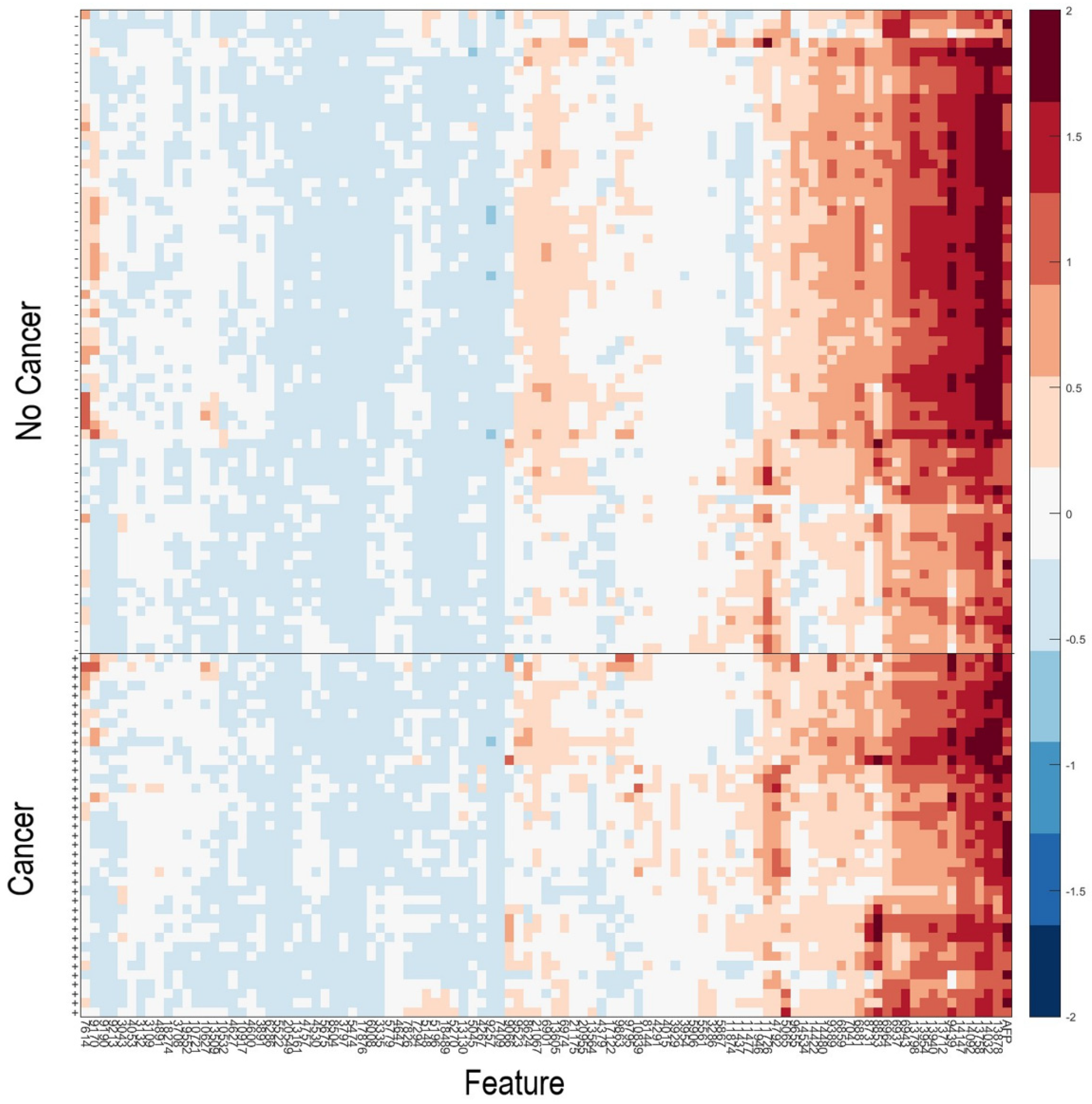
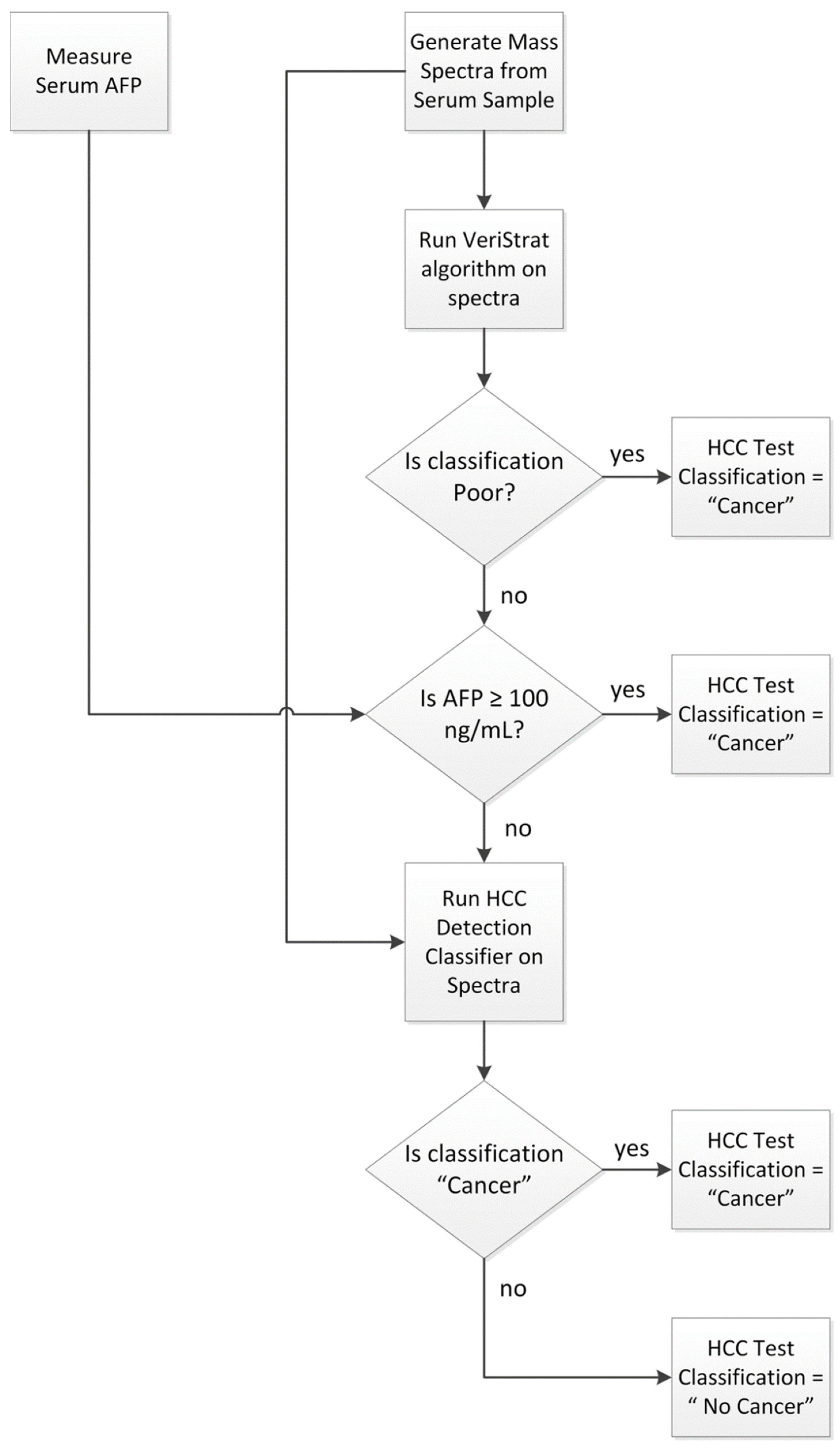
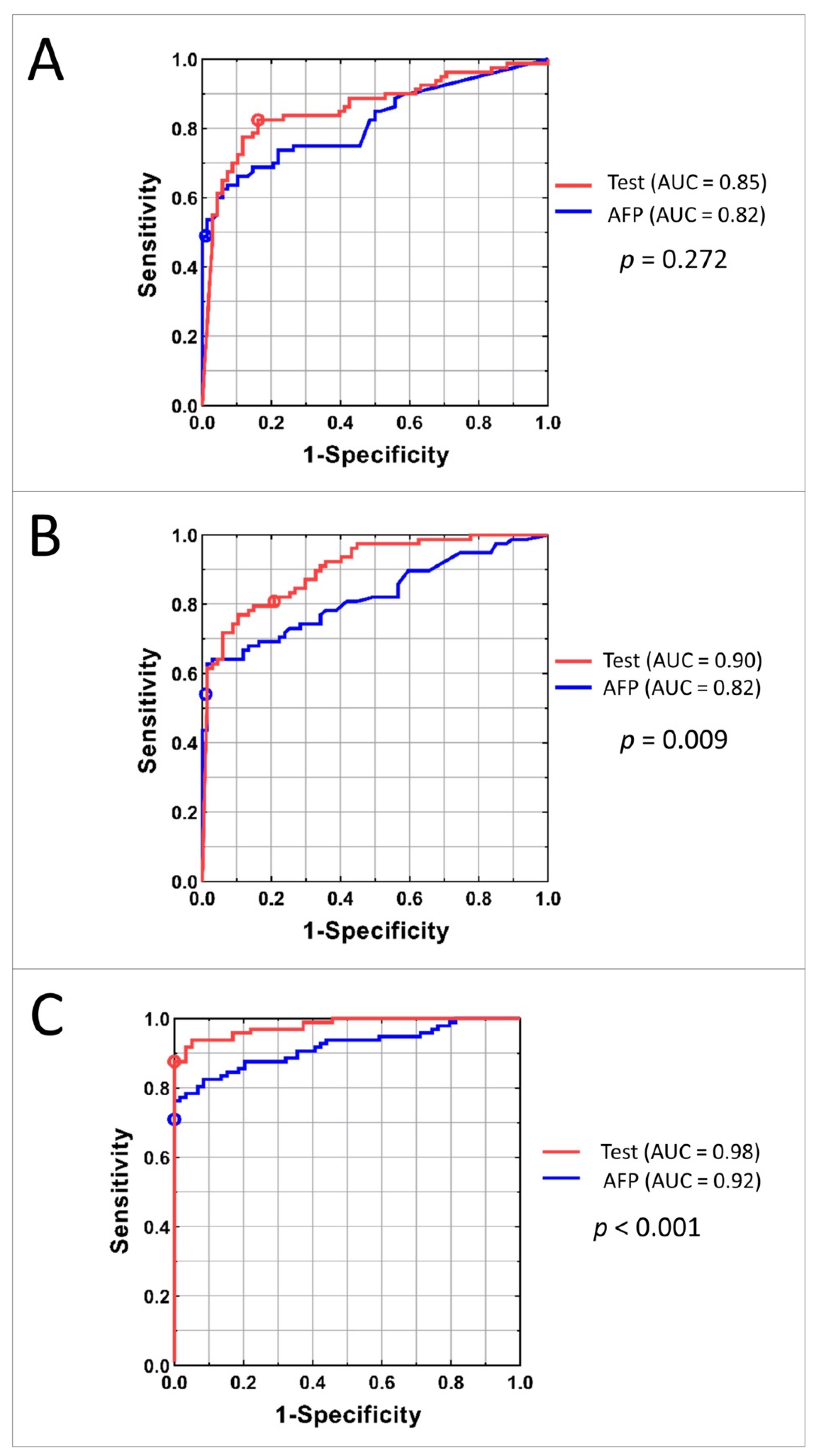
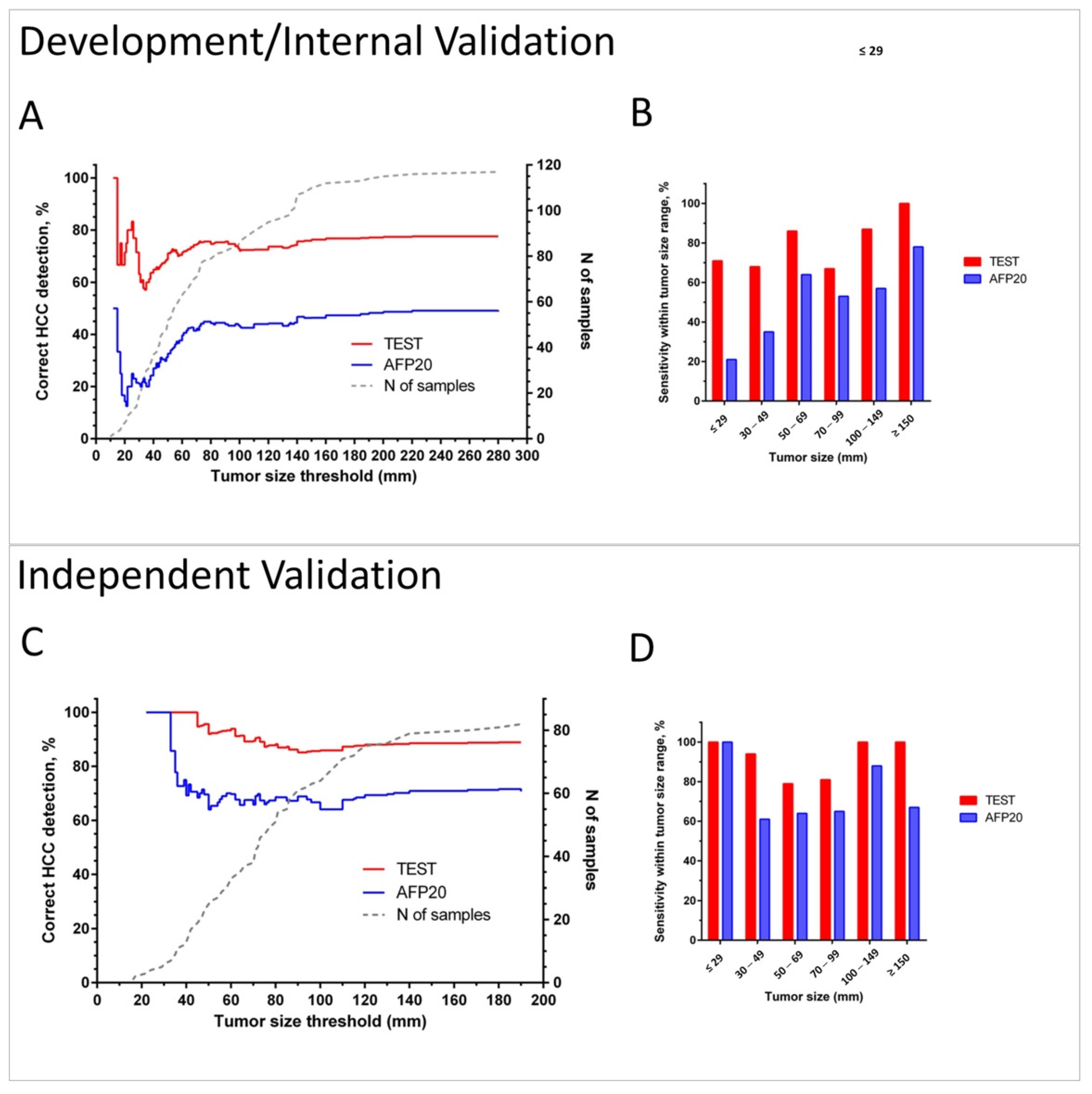
| Patient Characteristic | Cohort | Set | |||||||||
|---|---|---|---|---|---|---|---|---|---|---|---|
| UTHSCSA | Greek | Roswell | Development | Internal Validation | |||||||
| HCC (n = 48) | No HCC (n = 52) | HCC (n = 110) | No HCC (n = 83) | HCC (n = 97) | No HCC (n = 59) | HCC (n = 80) | No HCC (n = 68) | HCC (n = 78) | No HCC (n = 67) | ||
| Age | median | 59.5 | 56 | 69 | 54 | 63 | 62 | 67 | 54.5 | 66 | 57 |
| range | 50–85 | 40–67 | 44–82 | 28–80 | 38–89 | 38–87 | 44–82 | 30–74 | 47–85 | 28–80 | |
| Gender | male, n (%) | 32 (67) | 25 (48) | 92 (84) | 60 (72) | 84 (87) | 40 (68) | 63 (79) | 42 (62) | 61 (78) | 43 (64) |
| female, n (%) | 16 (33) | 27 (52) | 18 (16) | 23 (28) | 13 (13) | 19 (32) | 17 (21) | 26 (38) | 17 (22) | 24 (36) | |
| MELD | median | 14 | 25 | 10 | NA | 11 | NA | 11 | 25 | 11 | 25 |
| range | 7–37 | 13–47 | 6–26 | NA | 6–38 | NA | 6–34 | 16–42 | 7–37 | 13–47 | |
| NA, n (%) | 13 (27) | 0 (0) | 2 (2) | 83 (100) | 14 (14) | 59 (100) | 7 (9) | 42 (62) | 8 (10) | 41 (61) | |
| Child-Pugh | A, n (%) | 30 (63) | 6 (12) | 72 (65) | 74 (89) | 53 (55) | NA | 35 (44) | 38 (56) | 37 (47) | 36 (54) |
| B, n (%) | 16 (33) | 38 (73) | 27 (25) | 7 (8) | 24 (25) | NA | 16 (20) | 3 (4) | 11 (14) | 4 (6) | |
| C, n (%) | 2 (4) | 8 (15) | 11 (10) | 2 (2) | 6 (6) | NA | 5 (6) | 1 (1) | 6 (8) | 1 (1) | |
| NA, n (%) | 0 (0) | 0 (0) | 0 (0) | 0 (0) | 14 (14) | NA | 24 (30) | 26 (38) | 24 (31) | 26 (39) | |
| BCLC status | A, n (%) | 48 (100) | NA | 3 (3) | NA | 29 (30) | NA | 26 (33) | NA | 25 (32) | NA |
| B, n (%) | 0 (0) | NA | 15 (14) | NA | 12 (12) | NA | 9 (11) | NA | 6 (8) | NA | |
| C, n (%) | 0 (0) | NA | 73 (66) | NA | 41 (42) | NA | 35 (44) | NA | 38 (49) | NA | |
| D, n (%) | 0 (0) | NA | 19 (17) | NA | 15 (15) | NA | 10 (13) | NA | 9 (12) | NA | |
| Liver disease | HBV, n (%) | 4 (8) | 1 (2) | 72 * (65) | 59 (71) | 3 (3) | 3 (5) | 41 (51) | 29 | 35 * (45) | 31 |
| origin | HCV, n (%) | 28 (58) | 21 (40) | 10 * (9) | 7 (8) | 26 (27) | 13 (22) | 18 (23) | 15 | 20 * (26) | 13 |
| Other/NA, n (%) | 17 (35) | 30 (58) | 29 (26) | 17 (20) | 68 (70) | 43 (73) | 21 (26) | 24 | 24 (35) | 23 | |
| Serum AFP | median | 4.7 | 1.6 | 37.0 | 2.0 | 4.0 | 2.6 | 16.8 | 1.8 | 25.0 | 2.1 |
| (ng/mL) | minimum | <0.8 | <0.8 | 1.1 | 0.8 | <1.5 | <1.5 | <1.5 | <1.5 | <0.8 | <0.8 |
| maximum | ≥10,000 | 15.0 | ≥10,000 | 115 | ≥10,000 | 11.5 | ≥10,000 | 20.0 | ≥10,000 | 115 | |
| Lesion size | <3, n (%) | 13 (27) | NA | 1 (1) | NA | 5 (5) | NA | 8 (10) | NA | 6 (8) | NA |
| (cm) | ≥3 and <5, n (%) | 21 (44) | NA | 13 (12) | NA | 18 (19) | NA | 16 (20) | NA | 18 (23) | NA |
| ≥5 and <7, n (%) | 4 (8) | NA | 18 (16) | NA | 14 (14) | NA | 12 (15) | NA | 10 (13) | NA | |
| ≥7 and <10, n (%) | 3 (6) | NA | 12 (11) | NA | 26 (27) | NA | 7 (9) | NA | 8 (10) | NA | |
| ≥10 and <15, n (%) | 2 (4) | NA | 21 (19) | NA | 16 (16) | NA | 12 (15) | NA | 11 (14) | NA | |
| ≥15, n (%) | 2 (4) | NA | 7 (6) | NA | 3 (3) | NA | 4 (5) | NA | 5 (6) | NA | |
| NA, n (%) | 3 (6) | NA | 38 (34) | NA | 15 (15) | NA | 21 (26) | NA | 20 (26) | NA | |
| Cohort | Development (n = 148) | Internal Validation (n = 145) | Independent Validation (n = 156) | ||||
|---|---|---|---|---|---|---|---|
| HCC (n = 80) | No HCC (n = 68) | HCC (n = 78) | No HCC (n = 67) | HCC (n = 97) | No HCC (n = 59) | ||
| Overall, n (%) | 66/80 (83) | 57/68 (84) | 63/78 (81) | 53/67 (79) | 85/97 (88) | 59/59 (100) | |
| Child–Pugh | A, n (%) | 28/35 (80) | 35/38 (92) | 30/37 (81) | 34/36 (94) | unknown | N/A |
| B, n (%) | 16/16 (100) | 3/3 (100) | 11/11 (100) | 2/4 (50) | unknown | N/A | |
| C, n (%) | 5/5 (100) | 1/1 (100) | 6/6 (100) | 1/1 (100) | unknown | N/A | |
| NA, n (%) | 17/24 (71) | 18/26 (69) | 16/24 (67) | 16/26 (62) | unknown | N/A | |
| Liver Disease Origin * | HBV, n (%) | 36/41 (88) | 28/29 (97) | 31/35 (89) | 29/31 (94) | 3/3 (100) | N/A |
| HCV, n (%) | 14/18 (78) | 10/15 (67) | 18/20 (90) | 8/13 (62) | 26/26 (100) | N/A | |
| Other/NA, n (%) | 20/26 (77) | 21/26 (81) | 18/27 (67) | 18/26 (69) | 56/68 (82) | N/A | |
| Category | Cohort | |||
|---|---|---|---|---|
| Development (n = 80) | Internal Validation (n = 78) | Independent Validation (n = 97) | ||
| BCLC status | A, n (%) | 19/26 (73) | 16/25 (64) | unknown |
| B, n (%) | 4/9 (44) | 3/6 (50) | unknown | |
| C, n (%) | 33/35 (94) | 35/38 (92) | unknown | |
| D, n (%) | 10/10 (100) | 9/9 (100) | unknown | |
| Lesion size (cm) | <3, n (%) | 6/8 (75) | 4/6 (67) | 5/5 (100) |
| ≥3 and <5, n (%) | 12/16 (75) | 11/18 (61) | 17/18 (94) | |
| ≥5 and <7, n (%) | 10/12 (83) | 9/10 (90) | 11/14 (79) | |
| ≥7 and <10, n (%) | 5/7 (71) | 5/8 (63) | 21/26 (81) | |
| ≥10 and <15, n (%) | 10/12 (83) | 10/11 (91) | 16/16 (100) | |
| ≥15, n (%) | 4/4 (100) | 5/5 (100) | 3/3 (100) | |
| NA, n (%) | 19/21 (90) | 19/20 (95) | 12/15 (80) | |
Publisher’s Note: MDPI stays neutral with regard to jurisdictional claims in published maps and institutional affiliations. |
© 2021 by the authors. Licensee MDPI, Basel, Switzerland. This article is an open access article distributed under the terms and conditions of the Creative Commons Attribution (CC BY) license (https://creativecommons.org/licenses/by/4.0/).
Share and Cite
Mahalingam, D.; Chelis, L.; Nizamuddin, I.; Lee, S.S.; Kakolyris, S.; Halff, G.; Washburn, K.; Attwood, K.; Fahad, I.; Grigorieva, J.; et al. Detection of Hepatocellular Carcinoma in a High-Risk Population by a Mass Spectrometry-Based Test. Cancers 2021, 13, 3109. https://doi.org/10.3390/cancers13133109
Mahalingam D, Chelis L, Nizamuddin I, Lee SS, Kakolyris S, Halff G, Washburn K, Attwood K, Fahad I, Grigorieva J, et al. Detection of Hepatocellular Carcinoma in a High-Risk Population by a Mass Spectrometry-Based Test. Cancers. 2021; 13(13):3109. https://doi.org/10.3390/cancers13133109
Chicago/Turabian StyleMahalingam, Devalingam, Leonidas Chelis, Imran Nizamuddin, Sunyoung S. Lee, Stylianos Kakolyris, Glenn Halff, Ken Washburn, Kristopher Attwood, Ibnshamsah Fahad, Julia Grigorieva, and et al. 2021. "Detection of Hepatocellular Carcinoma in a High-Risk Population by a Mass Spectrometry-Based Test" Cancers 13, no. 13: 3109. https://doi.org/10.3390/cancers13133109
APA StyleMahalingam, D., Chelis, L., Nizamuddin, I., Lee, S. S., Kakolyris, S., Halff, G., Washburn, K., Attwood, K., Fahad, I., Grigorieva, J., Asmellash, S., Meyer, K., Oliveira, C., Roder, H., Roder, J., & Iyer, R. (2021). Detection of Hepatocellular Carcinoma in a High-Risk Population by a Mass Spectrometry-Based Test. Cancers, 13(13), 3109. https://doi.org/10.3390/cancers13133109





